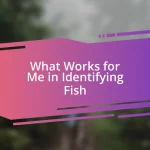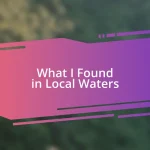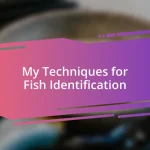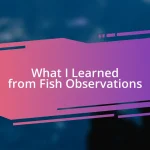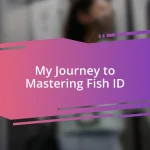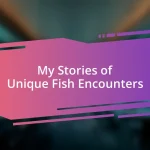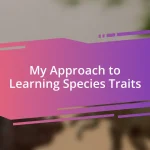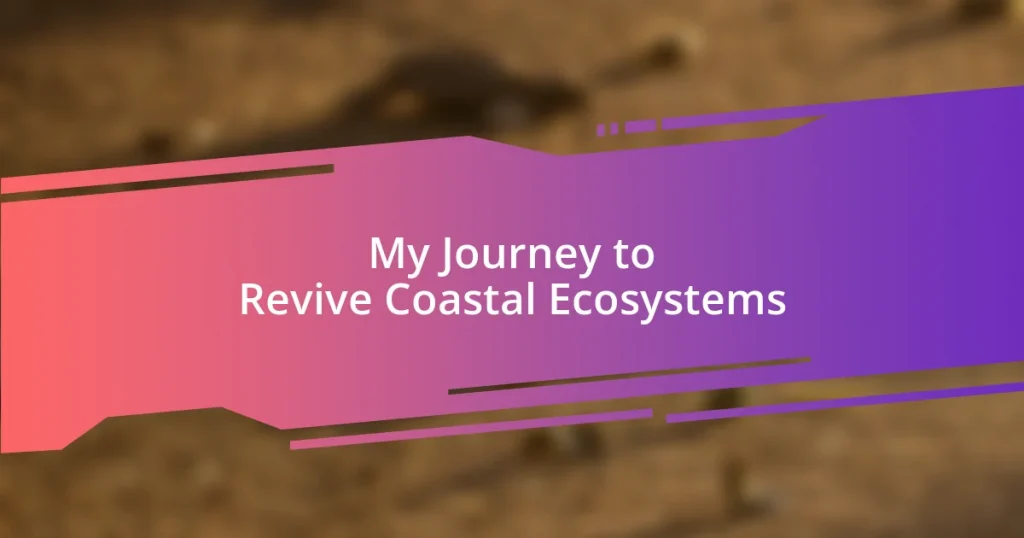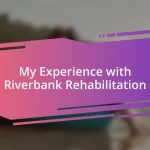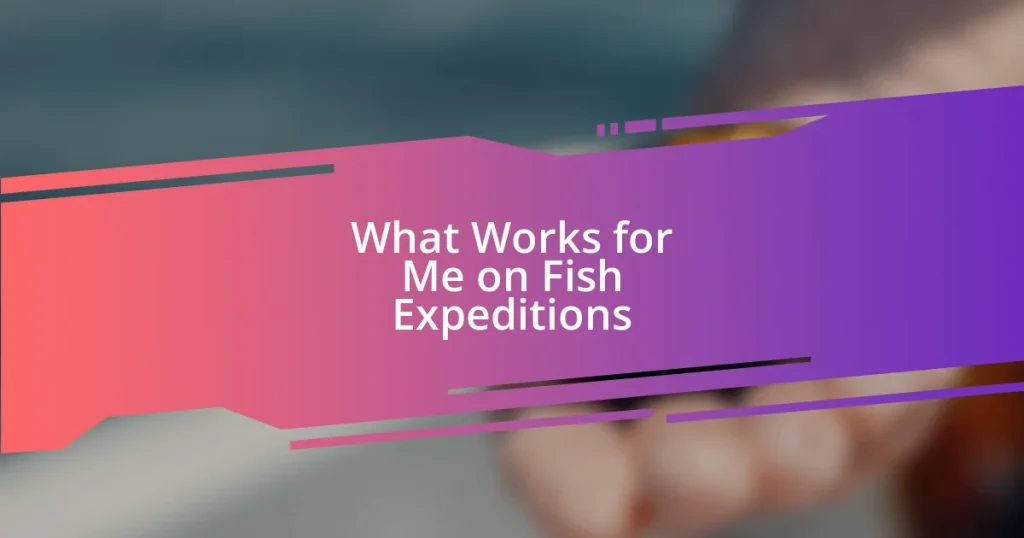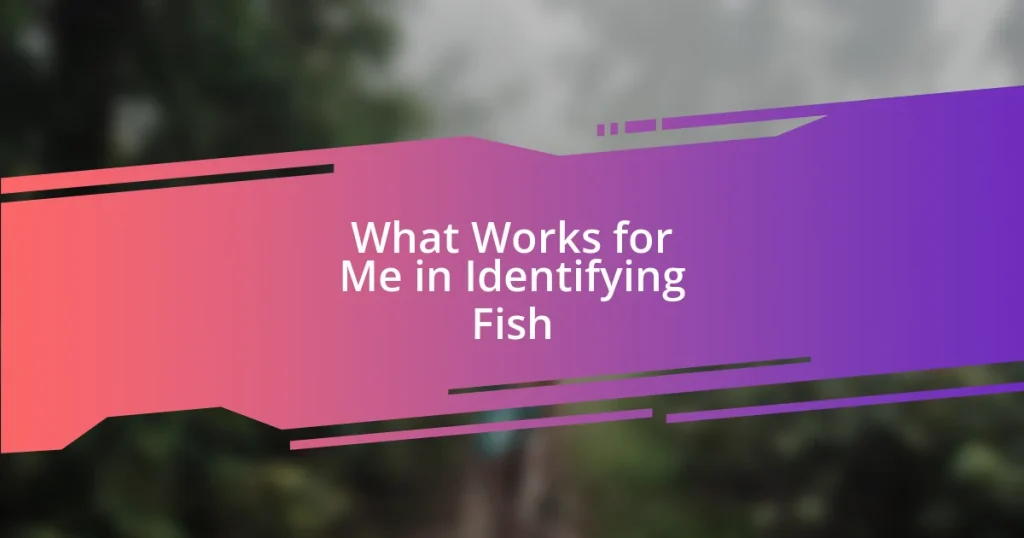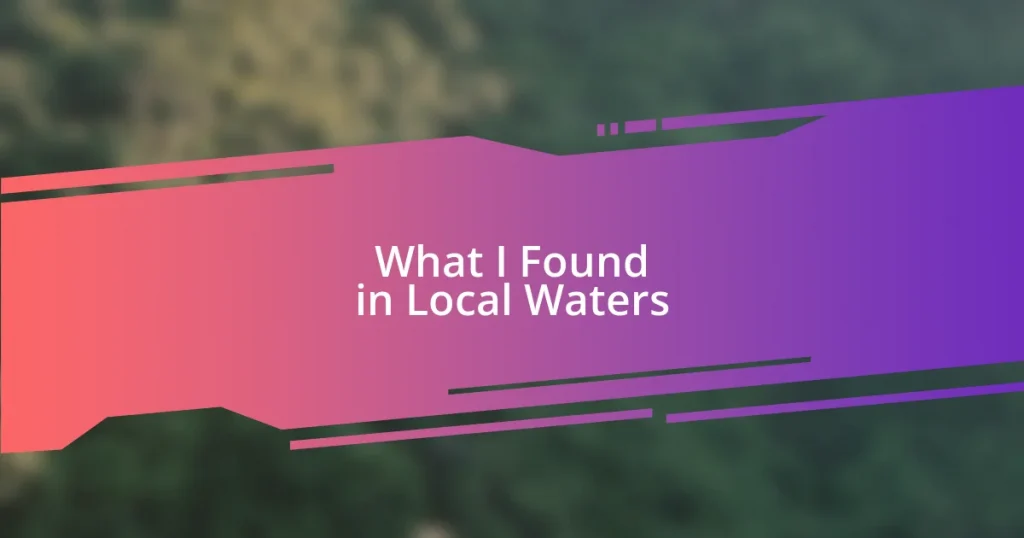Key takeaways:
- Coastal ecosystems, including mangroves and salt marshes, are vital for biodiversity, climate resilience, and supporting local livelihoods but are under threat from pollution, overfishing, and climate change.
- Revitalization efforts, such as community engagement and monitoring, are essential for restoring these ecosystems, improving water quality, and fostering a sense of stewardship among local populations.
- Sharing success stories and lessons from restoration projects can inspire communities and highlight the positive impact of conservation efforts on both the environment and personal narratives.
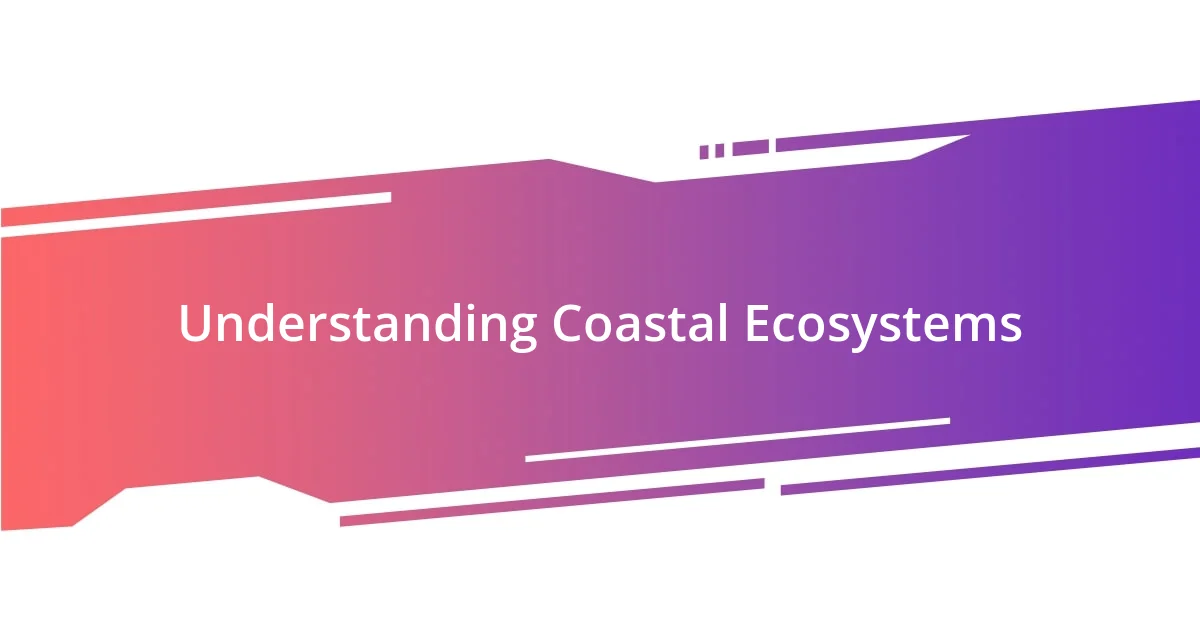
Understanding Coastal Ecosystems
Coastal ecosystems are unique environments where land meets the ocean, teeming with life. I still remember the first time I snorkeled in a coral reef; vibrant colors and diverse species flourished beneath the surface, reminding me how interconnected everything is. Have you ever stopped to think about how these ecosystems sustain not just marine life but also the livelihoods of coastal communities?
Mangroves, seagrasses, and salt marshes are integral parts of these ecosystems, providing habitat for myriad species and acting as natural buffers against storms. I vividly recall walking through a mangrove forest, the salty air filled with the sounds of chirping birds and rustling leaves. It struck me just how essential these plants are for carbon sequestration and shoreline protection. Isn’t it fascinating how something that might seem obscure to many plays such a crucial role in climate regulation?
Understanding the delicate balance within coastal ecosystems is vital, as each element, from the tiniest organism to the largest predator, plays a specific role. When I learned about the food webs in these areas, it was eye-opening to realize that a single disruption could ripple out, impacting everything. Have you ever considered the implications of losing even one species? The protection and restoration of these ecosystems should become a priority for us all, especially as we face the challenges posed by climate change.
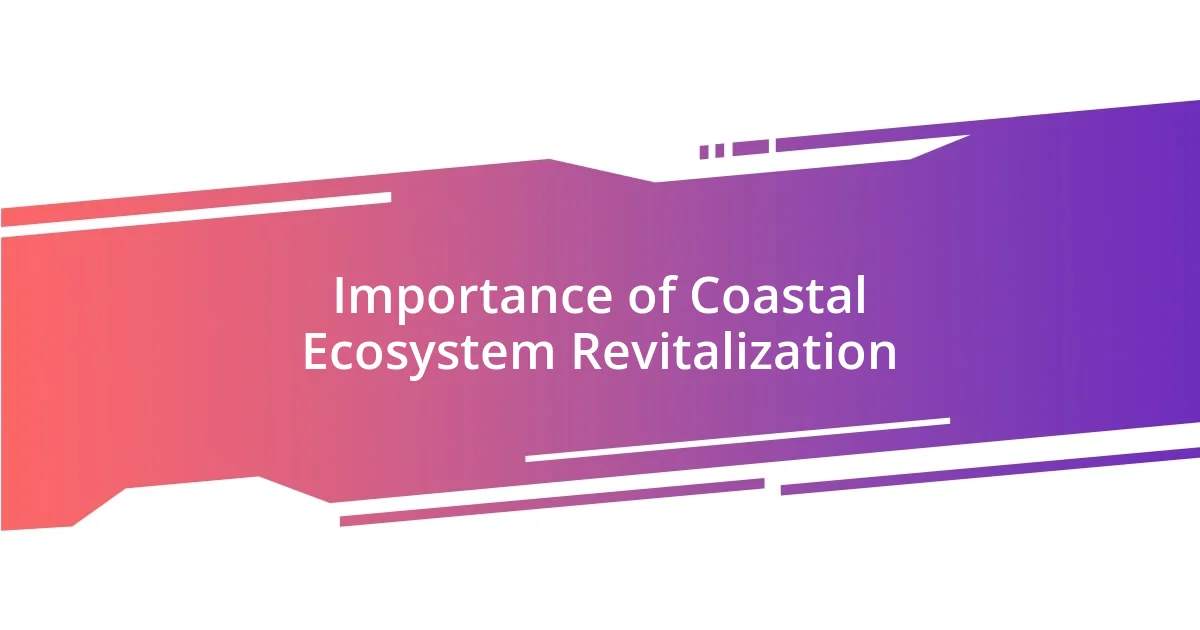
Importance of Coastal Ecosystem Revitalization
Revitalizing coastal ecosystems is not just beneficial—it’s essential. When I think about the incredible biodiversity these areas support, I can’t help but feel a sense of urgency. Just a few years back, I witnessed the shocking aftermath of a coastal development project that destroyed mangrove forests. The shifting sands and disturbed habitats led to a noticeable decline in local fish populations, which deeply affected the community’s fishing economy. Isn’t it heartbreaking how one action can ripple through the entire ecosystem and disrupt lives?
The importance of these ecosystems extends beyond their beauty; they serve as critical guards against climate change. During a storm, I stood on a beachfront and felt the power of the waves, but I also noticed the absence of lush marshlands that once softened the blow. The emotional weight of knowing that my childhood beach experiences might become memories instead of realities is staggering. Restoring these ecosystems offers a buffer against rising seas and extreme weather—something we can’t afford to overlook.
Additionally, revitalization efforts help improve water quality and increase carbon absorption. I still recall the first time I participated in a community cleanup of a polluted estuary. The transformation was almost magical—what once seemed like a lifeless stretch of water started to come alive. The sight of fish returning to their natural habitat was not just revitalizing to the ecosystem, but it filled my heart with hope and purpose. Can we really afford to turn our backs on such precious resources?
| Aspect | Importance of Coastal Ecosystem Revitalization |
|---|---|
| Biodiversity | Supports numerous species, helping maintain ecological balance. |
| Climate Resilience | Acts as natural barriers against storms and rising sea levels. |
| Economic Stability | Empowers local communities through sustainable fishing and tourism. |
| Water Quality | Filters pollutants and improves overall marine health. |
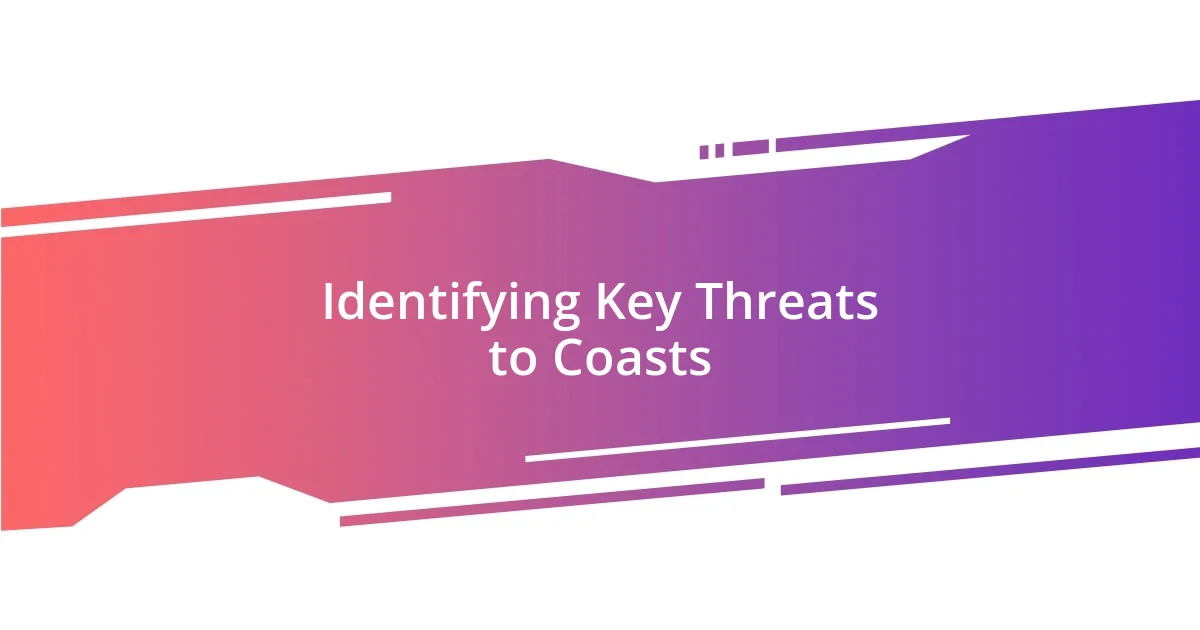
Identifying Key Threats to Coasts
Identifying the key threats to coastal ecosystems is crucial in understanding how we can act to protect them. I remember visiting a beautiful beach only to find plastic debris scattered everywhere, a stark reminder of pollution’s far-reaching effects. Marine litter not only harms wildlife but can also disrupt local economies reliant on tourism. While pollution is a visible threat, there are several underlying issues that require our attention:
- Coastal Development: Often leads to habitat loss and alters natural landscapes.
- Climate Change: Results in rising sea levels and increased storm intensity, wreaking havoc on vulnerable areas.
- Overfishing: Disrupts the balance of marine populations and diminishes biodiversity.
- Invasive Species: These uninvited newcomers can outcompete native species, leading to ecosystem degradation.
- Aquaculture Practices: These can introduce pollution and alter local water ecosystems if not managed sustainably.
Each of these threats carries its own weight, but together they create a challenging environment for coastal ecosystems to thrive. I often think of the time I went kayaking in a once-thriving lagoon that now seemed desolate due to nutrient runoff. The water was murky, and the vibrant life I once saw was replaced with a silence that echoed my concerns. This experience served as a profound wake-up call, highlighting the urgent need to tackle these key threats with effective, informed strategies.
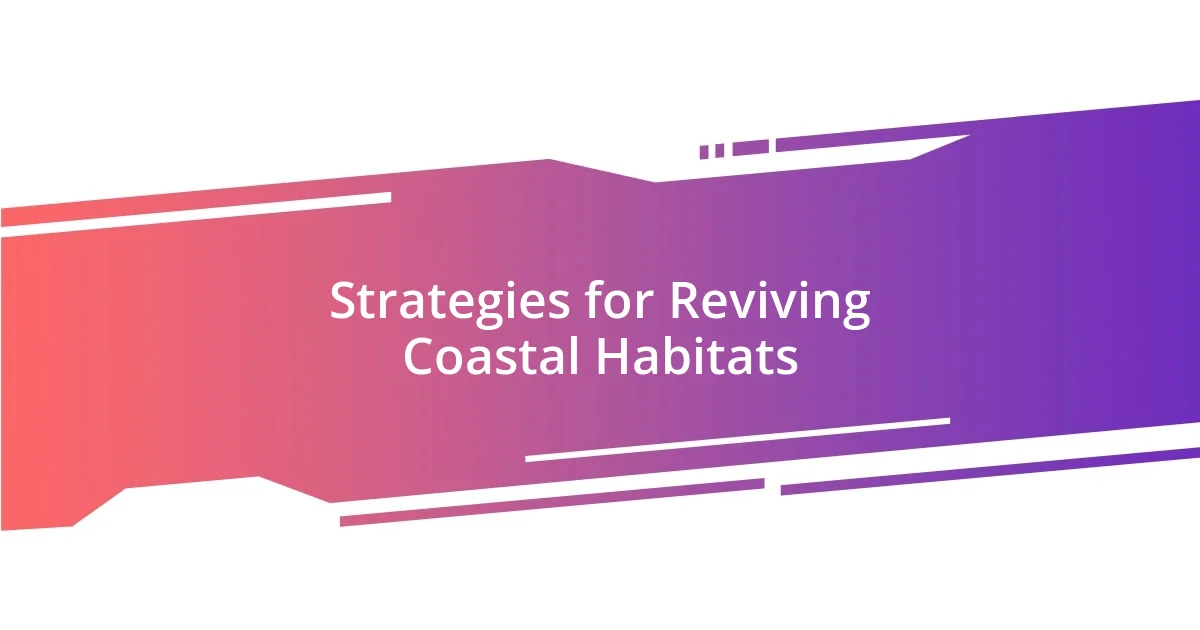
Strategies for Reviving Coastal Habitats
One effective strategy for reviving coastal habitats is the restoration of mangrove forests, which I’ve seen transform barren shorelines into vibrant ecosystems. I remember volunteering for a project where we planted saplings in what was once a desolate area. With each tree we planted, I felt a sense of purpose and watched as the shoreline gradually regained its richness. These forests not only provide shelter for countless marine species but also act as natural buffers, absorbing storm surges and improving local water quality. Isn’t it remarkable how something as simple as planting trees can ignite such profound changes?
Another impactful approach is community engagement in restoration efforts. During a recent beach clean-up, I saw families, friends, and strangers coming together with a shared goal. The camaraderie was infectious! It reminded me that when communities come together to protect their environment, they foster a sense of ownership and pride. Moreover, these initiatives can lead to sustainable practices, ensuring that future generations also cherish these coastal gems. What could be more motivating than seeing the fruits of your labor contribute to a cleaner, healthier coast?
Education plays a pivotal role in these strategies as well. I once attended a workshop on the effects of coastal erosion, and it was eye-opening. I walked away not just informed but inspired to share that knowledge with others. When people understand the delicate balance of coastal ecosystems, they’re more likely to advocate for their protection. Isn’t it empowering to realize that knowledge can spur collective action? It’s a cycle of awareness, action, and restoration that can make a lasting impact on our shores.
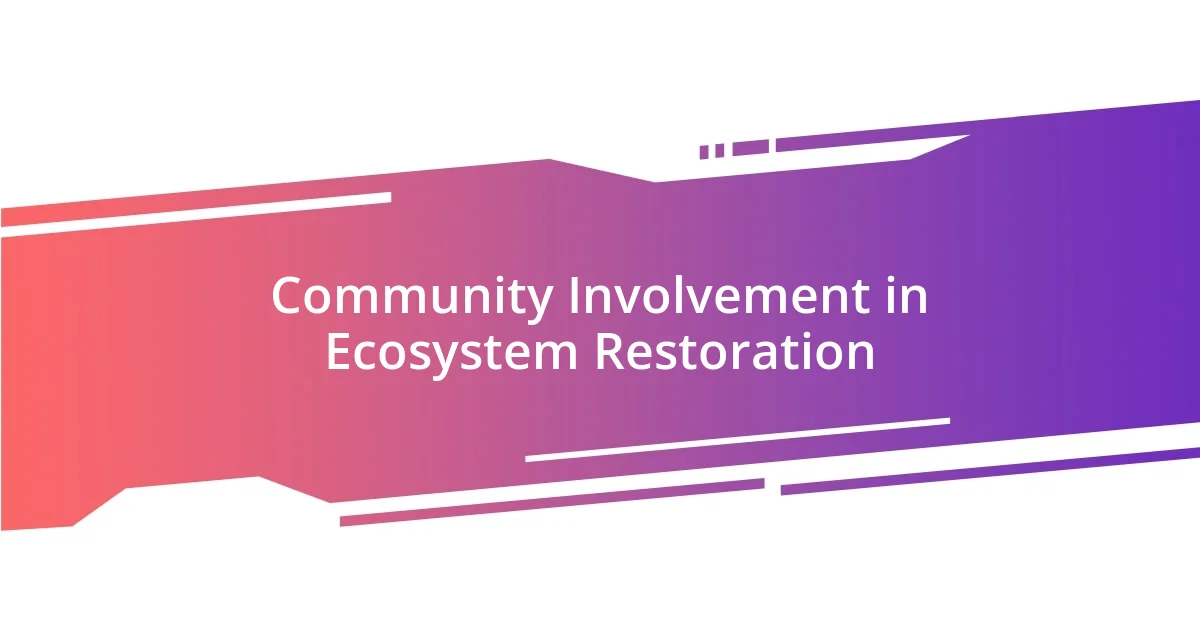
Community Involvement in Ecosystem Restoration
Engaging the community in ecosystem restoration is a beautifully transformative process, one that I’ve had the privilege to witness firsthand. During a local event, I remember meeting a group of high school students who were investing their Saturday in the restoration of a tidal marsh. Their enthusiasm was palpable; they eagerly shared their findings about native species and their importance in maintaining ecological balance. How amazing is it to see young people taking ownership of their local environment? Their energy reminded me that restoration isn’t just about planting trees or cleaning beaches—it’s about nurturing a sense of stewardship that can last a lifetime.
One time, I organized a workshop on coastal conservation, inviting local residents to learn about sustainable practices. The questions that emerged were enlightening—people wanted to know how their daily choices impacted the environment. It was during this conversation that I discovered a genuine desire for change within the community. I felt a surge of hope as we discussed simple actions everyone could take, like reducing plastic use or participating in local monitoring programs. Isn’t it incredible how a little information can spark a massive shift in mindset?
I’ve also seen the profound effects of collaboration between local organizations and community members. I recall a partnership that brought together fishermen and environmentalists to discuss sustainable fishing practices. Initially hesitant, both groups ended up finding common ground focused on preservation. It struck me how powerful it is when diverse voices unite for a shared cause. Why is it that we often overlook the potential of collective dialogue? Through these engagements, communities realize their role in ecosystem restoration isn’t just valuable; it’s essential for a healthy marine future.

Monitoring and Measuring Ecosystem Health
Monitoring ecosystem health is crucial for understanding the impact of restoration efforts. I remember participating in a local study where we collected data on water quality and biodiversity before and after a mangrove restoration project. Seeing those numbers come to life made me appreciate the fragility of these ecosystems and the need for consistent tracking to gauge progress. What if we didn’t monitor these changes? Would we overlook vital insights that could enhance our conservation strategies?
In my experience, using technology has revolutionized how we measure ecosystem health. During a recent beach survey, we utilized drones to survey coastal vegetation and monitor erosion patterns. The aerial views provided insights I hadn’t expected, showing how subtle changes can indicate larger ecological shifts. It made me wonder—how much more could we learn with even better tools at our disposal? With these innovations, we can gather valuable data and refine our approaches, ensuring our efforts are informed and effective.
I also find that community participation in monitoring fosters a deeper connection to the environment. Last summer, I collaborated with local volunteers to track bird populations along the shoreline. As we recorded each sighting, I could sense a shift in how we all viewed the ecosystem. We weren’t just participants; we became stewards, recognizing that our observations contribute to an overarching narrative of coastal health. Isn’t it inspiring to know that our collective efforts can help shape the future of these vital environments? Monitoring and measuring ecosystem health isn’t just about data; it’s about weaving our stories into the larger tapestry of conservation.
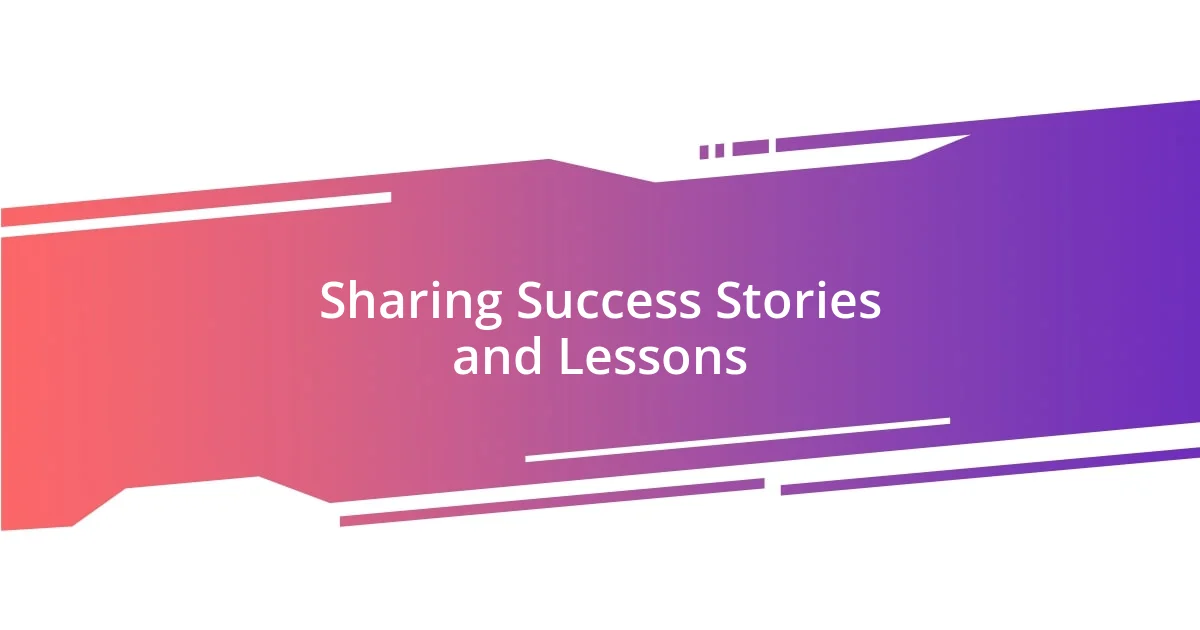
Sharing Success Stories and Lessons
I’ve had the chance to hear firsthand about the remarkable recovery of certain coastal habitats. At a community gathering, a local fisherman shared his story of how restocking native fish species revitalized his catch. His eyes lit up as he spoke about returning to waters that were once barren, now bustling with life. It struck me—do we often underestimate how these small victories in restoration can reshape entire communities? The joy in his voice was contagious, reminding us that success stories are not just statistics; they are the heartbeat of environmental recovery.
One memorable lesson I’ve learned through collaboration came during a project focused on restoring oyster reefs. We invited experts to train volunteers in planting and monitoring, and I was amazed to witness the transformation in attitudes. A retiree shared how her late husband had once harvested oysters for the family, and participating in this project allowed her to reconnect with his memory. Isn’t it incredible how restoration can heal not just ecosystems, but also our personal narratives? Those stories exemplify how our shared history with the environment shapes our present actions.
Reflecting on these experiences, I’ve realized that sharing success stories must go beyond mere numbers or data points. They need emotion, like the passion I felt when community members celebrated our first signs of new wildlife returning to a restored area. How can we ensure these powerful narratives are told widely? By amplifying voices of those directly impacted, we can inspire others to engage in ecosystem revival efforts. After all, when people see the change that’s possible, it ignites a spark to become part of the solution.

